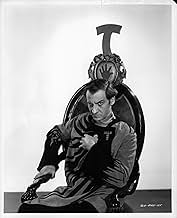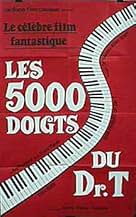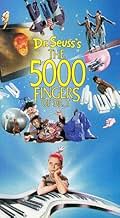CALIFICACIÓN DE IMDb
6.7/10
4.8 k
TU CALIFICACIÓN
Un chico viaja a un mundo fantástico con la ayuda de un fontanero, donde debe salvar a otros niños que como él tocan el piano de las mazmorras de un profesor de música dictatorial que contro... Leer todoUn chico viaja a un mundo fantástico con la ayuda de un fontanero, donde debe salvar a otros niños que como él tocan el piano de las mazmorras de un profesor de música dictatorial que controla a su madre con la mente.Un chico viaja a un mundo fantástico con la ayuda de un fontanero, donde debe salvar a otros niños que como él tocan el piano de las mazmorras de un profesor de música dictatorial que controla a su madre con la mente.
- Nominado a 1 premio Óscar
- 1 nominación en total
Jack Heasley
- Uncle Whitney
- (as John Heasley)
George Chakiris
- Dancer
- (as George Kerris)
Alan Aric
- Elevator Operator
- (sin créditos)
Alvin Beam
- Terwilliker's Valet
- (sin créditos)
Tony Butala
- Playback vocalist for Tommy Rettig
- (sin créditos)
Kim Charney
- Kim - Boy in Line
- (sin créditos)
Ward Ellis
- Terwilliker's Valet
- (sin créditos)
Luigi Faccuito
- Dancer in Dungeon Ballet
- (sin créditos)
Henry Kulky
- Stroogo
- (sin créditos)
Diki Lerner
- Dancer in Dungeon Ballet
- (sin créditos)
Harry Wilson
- Guard
- (sin créditos)
- …
Opiniones destacadas
Theodore Geisel, better known as Dr. Seuss, the wonderful writer of children's books, wrote the story in which this movie is based on. Allan Scott translated it for the screen and Roy Rowland directed the gorgeous Technicolor production that was shown recently on cable. This 1953 film relied on the use of color, which still shows crisp and sharp, something that other films using the technique didn't achieve.
The story reminds us a bit of "The Wizard of Oz", since it involves the vivid imagination of a young boy who is terrorized by his piano teacher. Since Bartholomew Collins doesn't have a father, his mother is the most important figure in his young life, until August Zabladowski, the best plummer in town, comes to the rescue and becomes a male role figure in the young boy's eyes.
The musical numbers, while not magnificent in comparison to MGM standards, are still well staged and the music by Frederick Hollander is tuneful to the ears. The amazing color cinematography by Franz Ploner gave this movie a great look and Al Clark's editing helped the story immensely.
The principals in the film do good work under Mr. Rowland's direction. The sweet looking Tommy Rettig, wearing his saddle shoes and beanie, steals the heart of the viewer with his earnest approach to the role of Bartholomew. Peter Lind Hayes and Mary Healy are seen as Mr. Zabladowski, and Mrs. Collins. Hans Conried's villainous Dr. T is one of the best assets of the film.
"The 5000 Fingers of Dr. T" is rarely seen these days, but it's worth a viewing for the sheer pleasure of the use of color and Dr. Seuss' wonderful timeless story.
The story reminds us a bit of "The Wizard of Oz", since it involves the vivid imagination of a young boy who is terrorized by his piano teacher. Since Bartholomew Collins doesn't have a father, his mother is the most important figure in his young life, until August Zabladowski, the best plummer in town, comes to the rescue and becomes a male role figure in the young boy's eyes.
The musical numbers, while not magnificent in comparison to MGM standards, are still well staged and the music by Frederick Hollander is tuneful to the ears. The amazing color cinematography by Franz Ploner gave this movie a great look and Al Clark's editing helped the story immensely.
The principals in the film do good work under Mr. Rowland's direction. The sweet looking Tommy Rettig, wearing his saddle shoes and beanie, steals the heart of the viewer with his earnest approach to the role of Bartholomew. Peter Lind Hayes and Mary Healy are seen as Mr. Zabladowski, and Mrs. Collins. Hans Conried's villainous Dr. T is one of the best assets of the film.
"The 5000 Fingers of Dr. T" is rarely seen these days, but it's worth a viewing for the sheer pleasure of the use of color and Dr. Seuss' wonderful timeless story.
An alienated boy misunderstood by his parents at home rebels against an exacting piano teacher whom he finds out has a sinister plot to rule the world.
I remember it best for its plaintive song "You Have No Right to Push Us Kids Around" later revived by Jerry Lewis in his TV appearances. The song is a cry about the angst of childhood. Part of the lyrics goes something like this: "Just because you have hair on your chest doesn't mean you're the best. Just because you have stayed longer on this planet doesn't mean you own it. You have no right to push us kids around just because we're closer to the ground." Under the megalomaniac piano teacher's plan, all children would be condemned to an eternity of piano practice trying to catch up with the ever increasing beat of a metronome. Spectacular "blow up" endings such as in James Bond movies satirized by Don Adams (Maxwell Smart) or even Mike Myers (Austin Powers) must have taken inspiration from this very early attempt at such.
Much belatedly did I find out that this story is by the revered "Dr." Seuss (he is not a real doctor you know) famous for witty, whimsical stories written in cute rhyming verses about outlandish animals (Green Eggs and Ham, Cat in a Hat)but praised by educators for their effectiveness in getting children to read. Seuss deserves Ph.Ds in education, psychology and literature even posthumously.
I remember it best for its plaintive song "You Have No Right to Push Us Kids Around" later revived by Jerry Lewis in his TV appearances. The song is a cry about the angst of childhood. Part of the lyrics goes something like this: "Just because you have hair on your chest doesn't mean you're the best. Just because you have stayed longer on this planet doesn't mean you own it. You have no right to push us kids around just because we're closer to the ground." Under the megalomaniac piano teacher's plan, all children would be condemned to an eternity of piano practice trying to catch up with the ever increasing beat of a metronome. Spectacular "blow up" endings such as in James Bond movies satirized by Don Adams (Maxwell Smart) or even Mike Myers (Austin Powers) must have taken inspiration from this very early attempt at such.
Much belatedly did I find out that this story is by the revered "Dr." Seuss (he is not a real doctor you know) famous for witty, whimsical stories written in cute rhyming verses about outlandish animals (Green Eggs and Ham, Cat in a Hat)but praised by educators for their effectiveness in getting children to read. Seuss deserves Ph.Ds in education, psychology and literature even posthumously.
I haven't seen it since but here is what I remember. I knew all the Dr. Seuss books by heart (I could read). I was taking piano lessons from our Protestant minister's wife who resembled Hans Conreid. My mom and I went on the bus to a large, metropolitan movie palace and we were well dressed. We watched the entire movie and then went home on the bus. Hans Conreid was always one of my favorites and even more recognizable as a voice. Lassie was a fixture later on our home TV. I don't think the movie had any real effect on me except that the books and my dreams were a lot better. I listened to radio every night as a child. I sometimes dreamed in black and white like most of the movies I saw as a child. I remember many of the scenes described in the written reviews and trailers. I'll see it again sometime. I'll let you know.
Others have commented on this but I just have to add after seeing this again today that the prison for orchestra members number looked like Busby Berkely on acid.. not to be missed!! A great goofy fun movie that has Dr. Seuss written ALL over it...
The rich imagination of Dr. Seuss and the suburban daydreams of the early 1950s combine to make this one-of-a-kind musical fantasy more than just a perverse novelty item: rarely has a film captured so well the unique perspective and peculiar logic of childhood. Kids will no doubt identify with the young hero, an unhappy piano student who dreams of liberating, with the help of a handsome plumber, 500 boys held captive at the mile long keyboard of his maniacal music tutor, Dr. Terwillicker (played by Mr. Fractured Flickers, Hans Conreid). But only adults will appreciate the shear strangeness of it all: the surrealistic architecture; the outrageous and colorful costume designs; and the improbable song and dance numbers, with nonsensical lyrics only Dr. Seuss could have written. At times it almost resembles a nightmare vision of child anxiety, but the passing years improve the film by restoring to it the innocence of the age in which it was made.
¿Sabías que…?
- ErroresAs Bart descends from the top of the ladder, he casts a shadow against the sky.
- Citas
Dr. Terwilliker: Is it atomic?
Bart Collins: Yes sir, VERY atomic!
- ConexionesEdited into TNT 100% Weird (1992)
- Bandas sonorasDream Stuff
Music by Friedrich Hollaender (as Frederick Hollander)
Lyrics by Dr. Seuss
Performed by Peter Lind Hayes Tommy Rettig (dubbed by Tony Butala)
Selecciones populares
Inicia sesión para calificar y agrega a la lista de videos para obtener recomendaciones personalizadas
- How long is The 5,000 Fingers of Dr. T.?Con tecnología de Alexa
Detalles
Taquilla
- Presupuesto
- USD 2,750,000 (estimado)
- Tiempo de ejecución
- 1h 29min(89 min)
- Relación de aspecto
- 1.85 : 1
- 1.37 : 1
Contribuir a esta página
Sugiere una edición o agrega el contenido que falta































